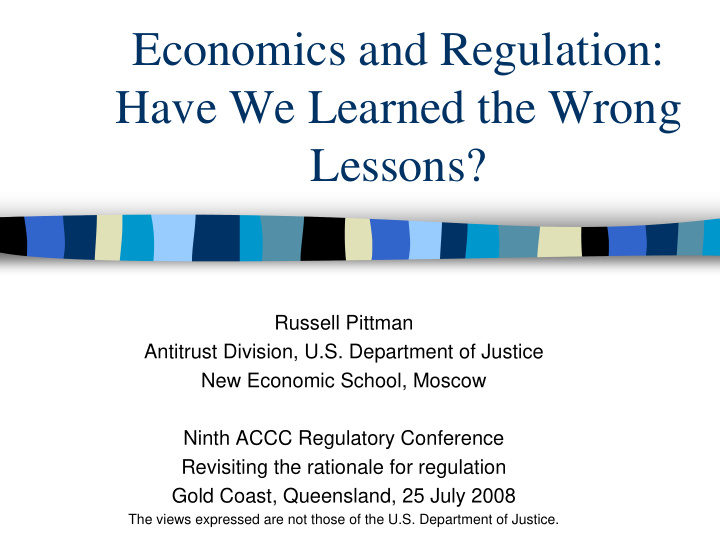



Economics and Regulation: Have We Learned the Wrong Lessons? Russell Pittman Antitrust Division, U.S. Department of Justice New Economic School, Moscow Ninth ACCC Regulatory Conference Revisiting the rationale for regulation Gold Coast, Queensland, 25 July 2008 The views expressed are not those of the U.S. Department of Justice.
4 Unreliable Lessons � 1. Profit margins tell us something about monopoly power. � 2. Regulators and antitrust enforcers should ignore distributional considerations. � 3. Price caps are good. Rate-of-return regulation is bad. � 4. Vertical separation is the way to create competition in network industries.
1. Profit margins tell us something about monopoly power. � Define: Profit margins = (TR – VC)/TR � 1. This is not what entrepreneurs or investors maximize. � 2. In LR equilibrium this must be positively related to industry capital intensity (i.e. rK/TR).
Profit margins, cont. � 3. The Lerner equation relates elasticity of demand to MC , not VC. � 4. Theory shows that in LR equilibrium, P = MC , not VC. � 5. When enforcement requires us to dig deep, VC is often a poor proxy for MC. – Traditional measurement issues (Fisher) – Predatory pricing – Wholesale electricity markets – Critical loss analysis
2. Regulators and antitrust enforcers should ignore distributional considerations. � Traditional rationales: – Impermissibility of interpersonal utility comparisons – “Division of labor” among policy instruments � But there are exceptions – Public finance and the “Frisch parameter” – Political science and models of voting and parties � And “division of labor” may beg the question
Distribution, cont. � In US and other countries, income distribution is becoming more unequal – Especially, ownership of both stocks and bonds � Thus transfers from buyers of goods to shareholders and bondholders on average regressive
Distribution, further cont. � “Intermediate goods” – Extensive literature on pass-through � Does this mean that monopsony is OK? – ANOTHER wrong lesson: “Even monopolists pass along cost reductions” � Sometimes it’s pretty clear – Sympathetic plaintiffs and prosecutorial discretion
3. Price caps are good. Rate-of- return regulation is bad. � High powered vs. low powered incentives – A spectrum: information revelation vs. allocative efficiency – Inability of governments to commit � Especially: developing country applications – Other priorities besides pure efficiency: attracting investment, increasing coverage, insuring against future expropriation
4. Vertical separation is the way to create competition in network industries. � Two issues that were under-appreciated – Potential for competition and competitive outcomes in “competitive” sector • Railways: Economies of density • Electricity: Repeat games and inframarginal rents – Loss of economies of vertical integration • Railways: “Where steel meets steel” • Electricity: New regulatory/coordinating institutions � Public utilities restructuring vs. Transactions cost economics: Ships passing in the night?
For further reading… “Electricity Restructuring in China: The Elusive Quest for Competition” (with Vanessa � Yanhua Zhang), EAG Discussion Paper 08-5, April 2008 � “Consumer Surplus as the Appropriate Standard for Antitrust Enforcement,” Competition Policy International 3 (2007), 205-224 � “Make or buy on the Russian railway? Coase, Williamson, and Tsar Nicholas II,” Economic Change and Restructuring 40 (2007), 207-221 “Competition in Freight Railways: ‘Above-the-Rail’ Operators in Central Europe and Russia” � (with 4 co-authors), Journal of Competition Law and Economics 3 (2007), 673-687. � “Options for Restructuring the State-Owned Monopoly Railway,” in Dennis and Talley, Railroad Economics (Research in Transportation Economics 20), 2007 � “Restructuring the Russian electricity sector: Re-creating California?”, Energy Policy 35 (2007), 1872-1883. “Structural Separation to Create Competition? The Case of Freight Railways,” Review of � Network Economics 4 (2005), 181-196. � “Russian Railways Reform and the Problem of Non-Discriminatory Access to Infrastructure,” Annals of Public and Cooperative Economics 75 (2004), 167-192. “Chinese Railway Reform and Competition: Lessons from the Experience in Other � Countries,” Journal of Transport Economics and Policy 38 (2004), 309-332. � “Vertical restructuring (or not) of the infrastructure sectors of transition economies,” Journal of Industry, Competition & Trade 3 (2003), 5-26.
Recommend
More recommend